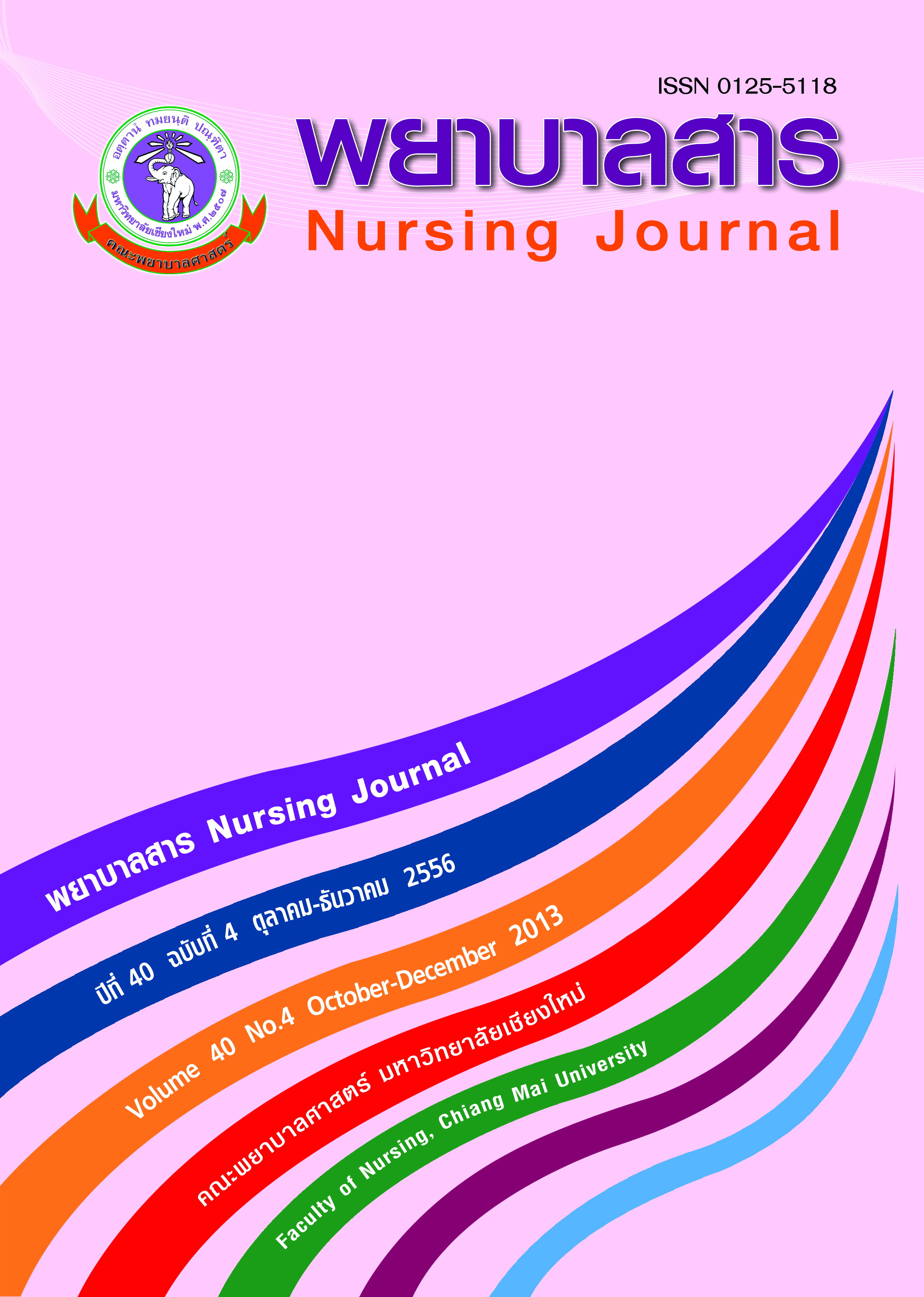ปัจจัยทำนายพฤติกรรมการป้องกันการสัมผัสฝุ่นธุปในผู้ประกอบอาชีพผลิตธูป
Keywords:
พฤติกรรมการป้องกัน, ผู้ประกอบอาชีพผลิตธูป, ฝุ่นธูป, Personal Protection Behavior, Incense Makers, Incense DustAbstract
บทคัดย่อ
ในอุตสาหกรรมการผลิตธูป ผู้ประกอบอาชีพผลิตธูปต้องประสบกับปัญหาสุขภาพอันเนื่องมาจากการทำงานโดยเฉพาะโอกาสเสี่ยงต่อการเกิดโรคจากการสัมผัสฝุ่นธูป การวิจัยครั้งนี้ เป็นการศึกษาเชิงพรรณนา มีวัตถุประสงค์เพื่อศึกษาปัจจัยทำนายพฤติกรรมการป้องกันการสัมผัสฝุ่นธูป ในผู้ประกอบอาชีพธูป กลุ่มตัวอย่างเป็นผู้ประกอบอาชีพผลิตธูปที่มีคุณสมบัติที่กำหนด จำนวน 250 คน ดำเนินการศึกษาในช่วงเดือนสิงหาคม-กันยายน 2554 เครื่องมือที่ใช้ในการวิจัยประกอบด้วย ปัจจัยส่วนบุคคล ความรู้เรื่องอันตรายของฝุ่นธูปและการป้องกันการสัมผัสฝุ่นธูปการรับรู้โอกาสเสี่ยงของการสัมผัสฝุ่นธูป การรับรู้ประโยชน์ของพฤติกรรมการป้องกันการสัมผัสฝุ่นธูป การรับรู้อุปสรรคของพฤติกรรมการป้องกันการสัมผัสฝุ่นธูป การรับรู้ความสามารถของตนเองในการปฏิบัติพฤติกรรมการป้องกันการสัมผัสฝุ่นธูป การได้รับคำแนะนำจากเพื่อนร่วมงาน การจัดหาอุปกรณ์ป้องกันอันตรายส่วนบุคคล และพฤติกรรมการป้องกันการสัมผัสฝุ่นธูป วิเคราะห์ข้อมูลโดยใช้สถิติเชิงพรรณนา การวิเคราะห์สัมประสิทธิ์สหสัมพันธ์เพียร์สัน ไคสแคว์ และการวิเคราะห์พหุคูณถดถอย
ผลการวิจัย พบว่ากลุ่มตัวอย่าง มีพฤติกรรมการป้องกันการสัมผัสฝุ่นธูป อยู่ระดับปานกลาง (M = 2.74, S.D. = 1.006) ซึ่งตัวแปรต้นทั้งหมด ยกเว้นการรับรู้ประโยชน์ของพฤติกรรมการป้องกันการสัมผัสฝุ่นธูปสามารถร่วมทำนายพฤติกรรมการป้องกันการสัมผัสฝุ่นธูป ร้อยละ 54.3 [F(10: 230) = 27.327, p<0.05] โดยมีตัวแปรการได้รับคำแนะนำจากเพื่อนร่วมงานเป็นตัวแปรที่สามารถทำนายพฤติกรรมการป้องกันการสัมผัสฝุ่นธูปได้มากที่สุด (beta = 0.535) การศึกษาครั้งต่อไปควรมีการนำผลการศึกษานี้ไปใช้เป็นข้อมูลพื้นฐานในการวางแผนดำเนินงานพัฒนาโปรแกรมปรับเปลี่ยนพฤติกรรมการป้องกันการสัมผัสฝุ่นธูปและเป็นแนวทางการศึกษาวิจัยต่อไป
คำสำคัญ : พฤติกรรมการป้องกัน ผู้ประกอบอาชีพผลิตธูป ฝุ่นธูป
Abstract
In the incense industry, incense makers encounter occupational health problems; especially,the risk of illness from contact with incense dust. A descriptive research method was used in thisstudy, which aimed at exploring the factors influencing personal protection behavior in relation tocontact with incense dust among incense makers. Two hundred fifty incense makers that met theinclusion criteria were recruited, and the study was conducted from August to September, 2011.The research instruments consisted of a demographic questionnaire that included the followingfactors: personal factors, knowledge of the hazards of incense dust, and protection from contactwith incense dust, the perceived susceptibility of contact with incense dust, the perceived benefitsof personal protection behavior regarding contacting with incense dust, the perceived barriers topersonal protection behavior regarding contact with incense dust, the perceived self-efficacy inengaging in personal protection behavior regarding contact with incense dust, receiving advicefrom colleagues, the provision of personal protective equipment, and the personal protectionbehavior regarding contact with incense dust. Data analysis was performed using descriptive statistics,Pearson’s product moment correlation coefficient, Chi-square, and multiple regression analysis.The results of studyThe results showed that the personal protection behavior from contact with incense dustwas at a moderate level (M = 2.74, S.D. = 1.006). All factors, as stated above except for the perceivedbarriers to personal protection behavior regarding contact with incense dust, were significantpredictors at 54.3% [F (10,230) = 27.327, p<0.05]. The most predictive variable was receiving advicefrom colleagues (beta = 0.535). The results of this study provide information for the developmentof programs to modify personal protection behavior in relation to contact with incense dust amongincense makers and can be used as a guide for further studies.
Key words: Personal Protection Behavior, Incense Makers, Incense Dust
Downloads
How to Cite
Issue
Section
License
บทความที่ได้รับการตีพิมพ์เป็นลิขสิทธิ์ของวารสารพยาบาลสาร
ข้อความที่ปรากฏในบทความแต่ละเรื่องในวารสารวิชาการเล่มนี้เป็นความคิดเห็นส่วนตัวของผู้เขียนแต่ละท่านไม่เกี่ยวข้องกับมหาวิทยาลัยเชียงใหม่ และคณาจารย์ท่านอื่นๆในมหาวิทยาลัยฯ แต่อย่างใด ความรับผิดชอบองค์ประกอบทั้งหมดของบทความแต่ละเรื่องเป็นของผู้เขียนแต่ละท่าน หากมีความผิดพลาดใด ๆ ผู้เขียนแต่ละท่านจะรับผิดชอบบทความของตนเองแต่ผู้เดียว






